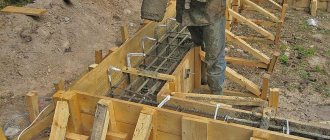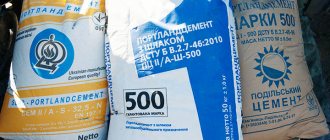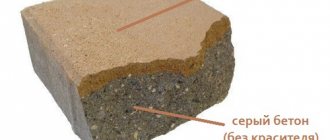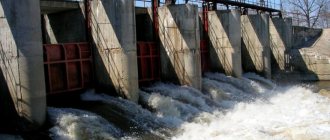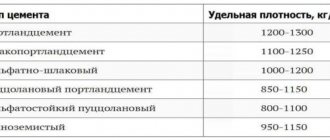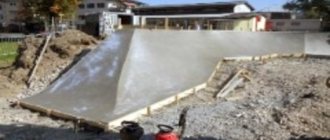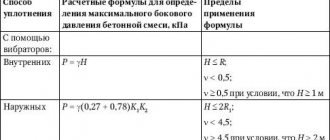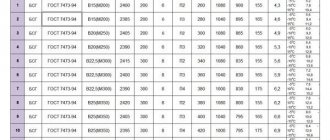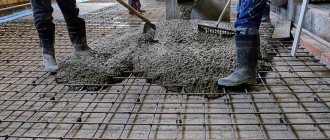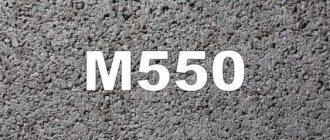Brief description of heavy concrete
Reinforced concrete products for construction are manufactured not only at specialized enterprises, but are also very often cast directly at the site being constructed. Not a single construction site is complete without concrete. To create a reliable structure with specified technical characteristics, heavy concrete is used, which, in accordance with building codes, has a volumetric mass of over 1,800 kg/m3.
Distinctive features of heavy concrete
The production of building materials is carried out in two categories: light and heavy concrete products. They differ significantly in physical and technological characteristics and, accordingly, in scope:
- Lightweight concrete is produced on the basis of “light” fillers, which significantly reduce the bulk density and increase thermal insulation properties. In addition, the lighter the concrete, the greater its porosity, which means low hydraulic resistance, so products made from lightweight concrete are used for internal non-critical structures without a strong dynamic destructive effect.
- Heavy concretes are characterized by high strength and low porosity, which guarantees excellent resistance to any mechanical and chemical influences. Building materials made from heavy concrete are applicable for especially critical structures with open (natural) operation, including for the construction of foundations, walls, and pouring floors.
Characteristics of heavy concrete
Calculation and selection of the composition and proportions of heavy concrete is carried out taking into account the required characteristics (properties):
- Strength is the main indicator of the ability of reinforced concrete products to withstand destructive loads. It is this indicator that indicates the area of application of concrete in high-rise buildings, foundations or hydraulic structures. The indicator is classified from B3.5 to B60, which corresponds to the tensile strength marking from M50 to M1000 (from 5 to 100 MPa).
- Thermal expansion and fire resistance of heavy concrete is an indicator of the possibility of using building products in temperature affected areas. Thus, pouring a floor made of heavy concrete has an expansion coefficient of no more than 0.5 mm per linear meter. Concrete can withstand temperatures up to 500 degrees (higher destruction occurs), and at a temperature of about 200 degrees its strength is lost by no more than 30%.
- Porosity, water resistance and frost resistance are related indicators, the amount of which determines the operational resistance of reinforced concrete products. The porosity of heavy concrete should not exceed 15%. Frost resistance is marked by its ability to withstand cyclic freezing from F50 to F1000. Heavy concrete is used in the construction of canals and bridges, so their water resistance is within the marking range W2 - W20 (the number is an indicator of the impact of water in kgf/cm2).
Application of heavy concrete
It is very important to correctly calculate and select the composition and proportions of heavy concrete, because The brand of concrete produced and its areas of application depend on this:
– Particularly critical structures and hydraulic structures must be erected from concrete of a grade not lower than M500.
– Critical structures, foundations and walls of high-rise buildings, slab foundations are made of M250 – M350 concrete.
– Individual construction can be carried out using M150 – M200 concrete.
– Non-critical concrete products for paths, blind areas and elements of road or landscape design can be cast with strength M50 - M150.
Structural features of heavy concrete
The composition and proportion of the components used for heavy concrete directly affects its technological and physical characteristics, so the calculation must be carried out quite accurately, which is more convenient to do using an online calculator. To cast high-quality concrete products with suitable technical characteristics, it is necessary to take into account a number of features of the production of heavy concrete:
- There are always two types of fillers used: large-format and small-format. Large-format aggregates (crushed stone or gravel) ensure the strength of concrete, and small-format aggregates, due to compacted distribution, increase the density and reduce the porosity of concrete. Filler of large formats with angular shapes provides less shrinkage of the casting and high operational dynamic strength. The fraction of fine aggregate also affects the characteristics of the concrete product: the finer it is, the higher the density and water resistance. It is worth considering that the strength of the concrete casting itself depends on the strength of the large-format aggregate.
- Plasticity of concrete or workability is the ability of a concrete mixture to completely fill a poured form with sufficient compaction to guarantee its design strength. Plasticity is marked from P1 (minimum) to P5 (maximum). To fill open areas using compaction (vibration) technology, you can take P1 concrete, but for complex structures it is necessary to use highly plastic concrete solutions from P3 to P5.
From complex to simple
Waterproofing in the garage is done to protect the car body, since concrete is not afraid of moisture. One of the simplest ways is to lay a dense polyethylene film on the sand so that moisture from the concrete does not go into the sand. In this case, concrete collapses due to its lower strength.
It is also necessary to remember about the use of reinforcing mesh, which must be laid inside the concrete to absorb the loads from the machine.
And moving on to laying the mortar itself, you need to remember that even for a small garage for a standard car you will need 2.5-3 m3 of concrete mixture. Since it is advisable to pour the floor in the garage at one time, even with the help of friends and one concrete mixer, the pleasure is long and difficult. And this is provided that all the materials and 3-4 friends are nearby. It is much easier to level the solution fed from the mixer.
Make everything simple - use the services of our company and get the desired result. The online calculator will help, depending on the purpose, calculate and select the composition of concrete mixtures containing various plasticizing additives and components that increase density and moisture resistance. And our transport will deliver concrete to your garage.
How much sand, crushed stone, cement is in 1m3 of concrete?
In construction, concrete grades are used that are designed to create products that perform specific functions in building frames. The parameters of concrete structures and their compliance with the tasks assigned to them depend on compliance with the volume and weight ratio of the components in concrete. Errors in establishing the proportions that make up a concrete batch lead to problems, even if ready-made concrete mix is used.
Mixture components and characteristics
Heavy concrete contains a certain brand of cement, sand and crushed stone, which, after mixing until smooth, are mixed with water. Cement is a binding powder. Portland cements are widely used, which are obtained by firing a composition of limestone and clay at high temperatures.
When crushed, gypsum is added to them, which determines the rate of hydration of the concrete solution. Typically, for the production of heavy concrete for various purposes from M100 to M450, cement grades M300 - M500 are used. The filler for binding the mixture is natural stone (crushed stone), obtained by crushing rock.
Component Requirements
It is important to understand what values of concrete properties and what grade of concrete are required. Therefore, the components of the concrete composition must meet certain requirements to obtain an artificial stone that has the specified quality parameters. When selecting, you should consider:
- for cements - setting time interval, volume (weight), activity;
- for sand - purity, humidity, size and shape of fractions, volume (weight), voidness;
- for crushed stone - size and shape of grain fractions (concentration of lamellar and needle-shaped forms), weight (volume), strength, moisture absorption, cleanliness;
- for water - purity, volume.
These parameters form the final brand indicators of concrete characteristics, as well as equally important intermediate indicators of properties - workability and density of the solution. Inattention to the initial quality of crushed stone, cement, water and sand leads to a shortage of brand values, for example, the strength of structures.
The most important parameters are the freshness of the cement and brand characteristics (for example, strength, frost resistance, etc.). The higher the numerical value of the brand, the higher the characteristics. Crushed stone for the mixture is not taken all in a row, but the required fractions (40 - 70, 20 - 40 mm and 5 - 20 mm).
For the filler, the large irregularity of grain shapes and surface roughness (limestone, crushed granite) are important. If gravel grinding with round grains is used, the strength is reduced. The filler should be removed from dust and dirt by washing. This requirement also applies to sand. It, as a sedimentary rock, should consist only of grains up to 0.3 cm in size and should not contain clay impurities.
To clean, the sand mixture should be washed with water. Sand is prepared by sequential sifting through meshes with cells of 0.25, 0.12 cm and 0.315 mm. The last fractions that pass the sieve become fillers. It is also important whether dry or wet sand is used. The moisture in it distorts the actual proportional relationship with other components.
The correct water-cement ratio ensures the required duration and intensity of the solution hydration reactions. The optimal amount of water is 40% of the weight of dry cement. Increasing its volume delaminates the mixture, contributing to a lack of strength; insufficient volume stops hardening. The solution should be thick, but not hard, workable, but not leaking through the seams of the formwork. The building materials market also offers the use of ready-made sand and gravel compositions (SGS), obtained by mining gravel and sand.
The river mixture of fillers contains less clay and dust than that mined in quarries. Additional enrichment of such a mixture with sand forms a completely finished composition. However, you should know that the proportion of sand in it should be 30% or higher (gravel up to 70%). Ignorance of the actual content may lead to a distortion of the correct ratio of components.
Calculations and indicators of components per cube of concrete
During production, it may be necessary to use units of volume of components, for example, when several cubes of components are delivered to the site for mixing concrete. Also, for example, crushed stone and sand can be supplied not in tons, but in cubes. The mass of cement M400 (M500) per cubic meter is from 1600 to 2500 kg, sand - 1500 kg, and crushed stone (fraction up to 4 mm) - 1410 kg. You need to know that adding sand to the mixture does not increase its volume beyond 1 m3. The fine structure of cement fills the voids between grains of sand, so the weight of the mixture increases, but the volume does not.
Therefore, one m3 can “absorb” up to 400 kg of sand without consequences. To find out how many components should be in 1 m3, you need to make a calculation. One cubic meter of any concrete mixture has a certain density. The calculation involves dividing the density of the concrete mixture of the declared brand by the sum of the parts of the components (Table 1) that are included in its composition. The answer is the weight of one part of the composition. Next, you need to multiply the result obtained by the numerical value of the parts indicated in the proportions for cement, sand, and crushed stone.
As a result of the calculation, it will become known how much of these materials is used to fill one cubic meter of concrete of the selected brand. The following approximate densities of grades of substance are accepted (in 1 cube):
- M400 and above - 2500 kg;
- M250, M300 - 2200 kg;
- M200 - 1800 kg;
- M100, M150 - 1600 kg.
Material consumption per cubic meter of installation is shown below in Table 2.
Table 2.
The correct calculation, taking into account the brand of cement, suggests that it should be half or more the value of the selected brand of future concrete.
Adviсe
The ingredients for mixing concrete are taken according to the recipe.
For the classic preparation of 1 cube of concrete, you will need the following proportions:
- cement – 1 part;
- sand – 2 parts;
- crushed stone - 4 parts;
- water – 0.5 parts.
It is necessary to take into account the quality of a component such as cement, the strength of which is determined by the production time. Bags of cement that had been in a barn for a month had their strength decreased by 10%. The following months have a similar effect. Therefore, the fresher the cement, the more reliable the foundation will be.
The moisture content of cement plays a key role in the strength of the future foundation. When water comes into contact with it, the cement hardens. If lumps of cement can be easily ground into dust, it is suitable for construction. Otherwise, the cement goes to waste.
Proportions of components in solution
The standard ratio of proportions of components for pouring the foundation is 1: 3: 5 (cement - sand - crushed stone). But that’s not all - in order for the solution to be of high quality, one should take into account the activity of Portland cement, the volume and weight of all components, the time of the beginning of setting and the end of hardening of the solution, to determine the grade - the mobility of the mixture, the characteristics of water separation in the solution, density and water resistance, and for reinforced concrete structures - voids of the solution, fractions of fillers, volume, humidity and weight of all components, composition and volume of organic substances, density of lamellar and needle-shaped filler granules.
| Components | Cement | Sand | Crushed stone | Water |
| Concrete M 200 – M 300 | 1 x 50kg bag | 8 x 10 liter buckets | 12 x 10 liter buckets | 3 10 liter buckets |
| 1 m 3 | 6 units | 48 units | 74 units | 20 units |
| Masonry mortar | 1 x 50kg bag | 16 x 10 liter buckets | – | 4 10 liter buckets |
| 1 m 3 | 6 units | 96 units | – | 23 units |
| Plaster mixture | 1 x 50kg bag | 13 x 10 liter | – | 3 10 liter buckets |
| 1 m 3 | 7 units | 91 units | – | 24 units |
Proportions in buckets
Technical and operational characteristics and brand of building material are determined by the ratio of the proportions of components per cubic meter of concrete, and depend on:
- The composition of cement - weight, activity of the substance, beginning and end of cement setting;
- Dependencies of proportions in a cube of concrete - volumetric weight, strength, mobility and water resistance;
- In sand - voids and fraction of the material, weight and volume of sand, humidity and clay content;
- In aggregates - volumetric mass, voidness, strength and humidity, degree of contamination.
| Concrete | Cement | Water-cement ratio | Filler size, mm | Water, liters per m 3 | Cement, kg per m 3 | Sand, tons per m 3 | Aggregate (gravel, crushed stone), tons per m 3 |
| M 100 | M З00 | 0,75 | Gravel 10 mm | 205 | 273 | 1,092 | 1,092 |
| 0,8 | Crushed stone 10 mm | 220 | 275 | 1,1 | 1,1 | ||
| 0,75 | Gravel 20 mm | 190 | 253 | 1,012 | 1,012 | ||
| 0,8 | Crushed stone 20 mm | 205 | 256 | 1,024 | 1,024 | ||
| M 200 | M 400 | 0,63 | Gravel 10 mm | 205 | 325 | 1,3 | 1,3 |
| 0,68 | Crushed stone 10 mm | 220 | 324 | 1,296 | 1,296 | ||
| 0,63 | Gravel 20 mm | 190 | 302 | 1,208 | 1,208 | ||
| 0,68 | Crushed stone 20 mm | 205 | 302 | 1,208 | 1,208 | ||
| M 250 | M 500 | 0,64 | Gravel 10 mm | 205 | 320 | 1,28 | 1,28 |
| 0,69 | Crushed stone 10 mm | 220 | 319 | 1,276 | 1,276 | ||
| 0,64 | Gravel 20 mm | 190 | 297 | 1,188 | 1,188 | ||
| 0,69 | Crushed stone 20 mm | 205 | 297 | 1,188 | 1,188 |
If the solution is formulated and mixed correctly, the concrete will be of high quality, and when it sets and hardens, its strength will be equal to the declared one, and will increase over time.
Water cement ratio
How to calculate the amount of cement
If less cement is added to the solution than is required according to the calculated data, then the concrete will become more mobile. This happens because when mixing the mortar and approximately calculating the amount of binder (Portland cement), an error of ≤ 1 proportional part can be made, and when calculating the aggregate, an error can be ≤ 5 parts. That is, if you add cement in small volumes, it may not hold a large volume of crushed stone or gravel.
Thus, after the incorrectly mixed mortar has fully gained strength, any rain or frost, heat or snow will destroy the concrete in one or two seasons. Therefore, it is better to err on the larger side than to make the mixture unreliable.
| Cement, brand | Concrete, brand | |||
| 100 | 75 | 50 | 25 | |
| 600 | 1 : 4.5 | 1 : 6 | — | — |
| 500 | 1 : 4 | 1 : 5 | — | — |
| 400 | 1 : 3 | 1 : 4 | 1 : 6 | — |
| 300 | 1 : 2,5 | 1 : 3 | 1 : 4,5 | — |
| 200 | – | 1 : 2,5 | 1 : 3 | 1 : 6 |
To know exactly how much cement is needed per 1 m 3 of concrete, you should know the brand of cement, which should have a designation 2 times higher than the brand of the ordered mortar. For pouring the foundation, you can use the M 200 grade, for the construction of concrete walls - M 300.
Making your own concrete
The proportional composition of the concrete solution depends on where it will be used, since for each specific case it is necessary to use the appropriate grade of concrete. Therefore, before starting calculations of how much cement is required per 1 cubic meter of concrete, you should clarify in which structures it will work.
The standard operation of mixing concrete mortar is carried out with the addition of nine parts of different building materials. This is 1 part Portland cement, 3 parts purified or river sand, and 5 parts gravel or crushed stone. In individual construction, mortar is most often measured in buckets, because it is more convenient to immediately supply and transport it. Therefore, the definition of “part of building materials” can be translated as “how many buckets of each substance are needed.” Thus, a proportion of 1:2 means that one bucket of Portland cement grade M 400 must be mixed with two buckets of clean sand. If the grade of cement will be increased (for example, to grade M 600), then use proportions of 1: 3.
Manual mixing of concrete
| Concrete hardening | Design compressive strength class | Strength (%) of design class | Conversion coefficient from Portland cement M 400 to M 300-M 500 | |
| ≤B 15 | 60-70 | 1,13 | 0,85 | |
| Natural hardening conditions at positive temperatures | ||||
| B 20-B З0 | 60-70 | – | 0,9 | |
| ≥B 35 | 60-70 | – | 0,92 | |
| ≤B 20 | ≤ 60 | 1,14 | 0,87 | |
| B 15-B З0 | 70-80 | – | 0,87 | |
| Heat treatment | ≤B 20 | 90-100 | _ | 0,9 |
What does consumption depend on?
The main and most important requirement for a concrete solution is compliance with the specified strength parameters after going through the full cycle of the hardening process. It is for this purpose that they determine how much cement is needed per 1 cubic meter of concrete, calculate the volumes of other components, and carefully monitor compliance with the technology for preparing the solution.
You can find the proportions in specialized reference books. But, in addition, you need to remember that cement consumption per 1 m3 depends on many factors that must be taken into account in the process of mixing concrete mortar.
What affects the consumption of cement in concrete:
- Operational parameters of concrete mortar - grade strength, density, setting time, water resistance, frost resistance, etc.
- Comfort of working with the solution - the required indicators of mobility, plasticity, which may largely depend on the ambient temperature and other factors.
- Characteristics of sand - grain size, type, volume of impurities: the sand should not contain more than 15% impurities, otherwise the filler must be washed, sifted, dried, etc.
- Characteristics of crushed stone - stone density, flakiness, level of contamination (if it does not meet the requirements, it is also advisable to wash and dry it).
- The need to introduce additional components into the composition - if the solution contains plasticizers and additives, then the number of bags of cement per cubic meter of solution may be less/more.
When calculating how much cement is needed per 1 cubic meter of concrete, be sure to take into account the brand of the powder itself and the solution that needs to be obtained in the end. It is desirable that the grade of cement be one and a half to two times higher than the grade of the mixture being mixed.
The higher the grade of cement, the smaller its volume in the solution. But you should not exceed the mark too much and take M600, for example, to fill a floor: oversaturation of the mixture can give a negative result.
How many bags of cement are needed per 1 m 3 of concrete?
For private construction, cement grades M 200 - M 300 are usually purchased in 50 kg bags. Therefore, it will also be easier to calculate in these units. To prepare a concrete solution from Portland cement brand M100, you will need 166 kg, or three bags and one and a half buckets (16 kg).
Ready-made concrete solution
Few private householders calculate how much cement is in 1 cubic meter of concrete, based on kilograms, tons, liters or cubic decimeters. The easiest way to measure the finished solution is in buckets, for example, cement grade M 400 - one bag, crushed stone or gravel - five bags, sand - three bags. As a result of using such proportions, concrete grade M 300 will be obtained - this strength is used for low-rise and high-rise construction.
The following amount of Portland cement is consumed per cubic meter of concrete:
- Brand M 450 – 470kg;
- M 400 – 415kg;
- M 300 – 320kg;
- M 250 – 305kg;
- M 200 – 240kg;
- M 150 – 205 kg;
- M 100 – 170 kg.
To minimize errors and inaccuracies in measurements and calculations, cement of the M 400 grade is most often used, rather than M 300 or M 250. In addition, when using low grades of cement, it will be required more for the same volume of finished concrete solution by approximately 25-30% .
Calculation of the amount of cement
How much concrete do you need for a garage floor?
The second important issue when laying garage flooring is the cost of concrete solution. They are calculated using a fairly simple formula, which uses the volume of concrete and the cost per cubic meter. How much concrete do you need for a garage floor? To calculate, it is necessary to determine the thickness of the main layer of the screed.
The minimum thickness of the finished garage floor covering should be 30 mm. This is enough to achieve strength that is sufficient for parking and periodically moving a passenger car. The increase in the thickness of the garage floor is associated with an increase in the mass of vehicles, an increase in area and the possible arrangement of a heating system. Nowadays, the most effective is considered to be a heated floor system, which will require a screed over pipes or cables. The maximum thickness of a concrete screed for a garage floor is 70 mm; it makes no sense to exceed it, since this will not provide a proportional increase in strength to the costs.
Calculating the amount of concrete for a garage floor is calculating the volume of solution that will be required to fill a surface of a known area with a layer of a given thickness, that is, the product of the surface area and the thickness of the coating during pouring. Since concrete is measured in cubic meters, a volumetric quantity, the calculation immediately answers your question.
How much water is needed for the solution
When preparing concrete mortar, it is recommended to use only clean water - without chemical and organic impurities and dirt. It is quite difficult to calculate the preliminary required volume of water, since both the binder and the aggregates have different moisture content each time. The water absorption of cement also depends on its brand, therefore, how much water is needed to prepare the solution will become clear when preparing the mixture. To obtain one cubic meter of medium plasticity concrete with coarse crushed stone as filler, you will need about 205 liters of water.
To prepare a high-quality concrete solution, you need to take only clean river or purified quarry sand, crushed stone of the calculated fraction without the presence of lamellar and needle-shaped grains, as well as fresh Portland cement. It is better to pre-rinse any crushed stone, even clean ones, and sift through a sieve with the calculated mesh sizes. It is also recommended to sift sand, regardless of its degree of purity.
Types of concrete mixtures
Concrete is distinguished by strength and density of composition, which directly depend on the types of crushed stone used and its relationship with other components. There are the following types of mixtures:
- Lightweight concrete has a density from 400 to 1600 kg/m³. The main filler here is sand, and ordinary crushed stone is practically not used. Instead, the solution is filled with shell rock, expanded clay and other light fillers. In most cases, the same amount of filler is taken as sand; in rare cases, a ratio of 1:2 is allowed.
- Heavy concrete with a value from 1600 to 2600 kg/m³. This is the most popular building material used everywhere. They use conventional types of aggregate of various fractions. Their quantity depends on the brand of solution and is entered in special tables.
- Extra-heavy or especially durable types have a density of about 3000 kg/m³ and higher. They use barite, hematite or magnetite rock of increased strength. Such compositions are expensive, so it is important to clearly know their ratio, which is calculated individually for each design.
Mixtures are characterized by strength grades. The most commonly used markings are from M100 to M400. In this case, there is a general rule that the strength of crushed stone should be twice the expected strength of the monolith. For example, M400 aggregate must be added to M200 concrete.
Calculation of the volume of components to create a concrete mixture
When carrying out concreting work on objects, it is important to know not only the volume of concrete required, but also the composition of concrete by volume of components. Calculation is not necessary when ordering a ready-made mixture, but at the same time, for making concrete on your own, knowing how to calculate the volume of all components is very important.
Are you choosing a building material? Here the properties of foam concrete and aerated concrete are compared.
Truck-mounted concrete pumps and truck-mounted concrete mixers: here their services are available for a reasonable fee.
Concrete consists of a mixture of cement, crushed stone or other filler, sand and water, so proper selection of the ratio of all components will ensure the reliability and durability of the structures being manufactured. Some of the main characteristics of the resulting concrete are the water-cement ratio (W/C), the brand of cement used and the characteristics of the filler; based on these data, you can select the ingredients for the brand of concrete required for the project. All indicators are tabular data and are given below:
Component ratio
This indicator is decisive for the production of a high-quality solution. Various types of aggregate can be added to the solution - dolomite, slag, recycled, gravel or granite. The first three have low and medium strength up to M800, the fourth and fifth can be used in heavy solutions and have indicators from M800 to M1200. Another important factor is the size of the filler being poured; the larger it is, the stronger the solution will be. The ratios of components in one cube of concrete are presented in the table:
| Concrete grade | Proportions of cement, sand and crushed stone | |
| for M400 | for M500 | |
| M100 | 1:4,1:6,1 | 1:5,3:7,1 |
| M150 | 1:3,2:5 | 1:4:5,8 |
| M200 | 1:2,5:4,2 | 1:3,2:4,9 |
| M250 | 1:1,9:3,4 | 1:2,4:3,9 |
| M300 | 1:1,7:3,2 | 1:2,2:3,7 |
| M400 | 1:1,1:2,4 | 1:1,4:2,8 |
| M450 | 1:1:2,2 | 1:1,2:2,5 |
The main requirement for the crushed stone used is that it must be the same size and not contain foreign impurities that significantly reduce the quality of the solution. Keeping the volumetric and mass parts of aggregates specified in the proportions will allow us to produce high-quality material with the declared characteristics.
Foundation composition
Pouring the load-bearing part of the structure is required to evenly distribute the weight of the house. The concrete base will prevent deformation and settlement and extend the life of the building. To fill the concrete foundation, use a mixture of cement, sand and gravel in a ratio of 1:3:5. This is the optimal numerical calculation. The quantitative volume of fillers depends on the brand of components, type of foundation, seismicity of the soil and climatic conditions.
